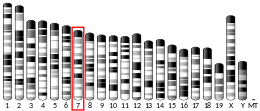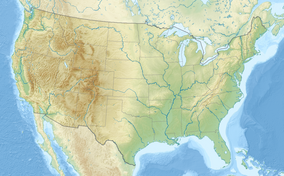PSMC4
PSMC426S proteasome AAA-ATPase subunit Rpt3로도 알려진 26S protease 규제 서브 유닛 6B는 인간에서 PSMC4 유전자에 의해 인코딩되는 효소다.[5][6][7]This protein is one of the 19 essential subunits of a complete assembled 19S proteasome complex[8] Six 26S proteasome AAA-ATPase subunits (Rpt1, Rpt2, Rpt3 (this protein), Rpt4, Rpt5, and Rpt6) together with four non-ATPase subunits (Rpn1, Rpn2, Rpn10, and Rpn13) form the base sub complex of 19S regulatory particle for proteasome complex.[8]
유전자
PSMC4 유전자는 ATPase subunit 중 하나를 암호화하고, ATPases의 트리플A 계열의 멤버로 샤퍼론 같은 활동을 한다.이 소분위는 간에서 고도로 발현된 핵호르몬 수용체 슈퍼 패밀리의 고아 구성원과, 간 온코프로틴인 간키린과 상호작용하는 것으로 나타났다.서로 다른 ISO 양식을 인코딩하는 두 개의 대본 변형이 식별되었다.[7]인간 PSMC3 유전자는 11개의 exon을 가지고 있으며 염색체 대역 19q13.11-q13.13에 위치한다.
단백질
인간 단백질 26S 프로테아제 조절 서브 유닛 6B는 크기가 47kDa이고 418개의 아미노산으로 구성되어 있다.이 단백질의 계산된 이론적 pI는 5.09이다.[9]
복합 조립체
26S 프로테아솜 콤플렉스는 보통 20S 코어 입자(CP 또는 20S 프로테아솜)와 배럴 모양의 20S 한쪽 또는 양쪽에 1개 또는 2개의 19S 규제 입자(RP 또는 19S 프로테아솜)로 구성된다.CP와 RP는 서로 다른 구조적 특성과 생물학적 기능을 가지고 있다.간단히 말해서, 20S 하위 단지는 카스파제 유사, 트립신 유사, 키모트립신 유사 활동을 포함한 세 가지 유형의 단백질 분해 활동을 제시한다.20S 서브유닛의 4개의 스택 링에 의해 형성된 챔버의 내측에 위치한 이러한 단백질 분해 활성 사이트는 무작위 단백질-엔자임 조우 및 제어되지 않은 단백질 저하를 방지한다.19S 규제 입자는 유비퀴틴 라벨이 부착된 단백질을 분해 기질로 인식하고, 단백질을 선형까지 펼치며, 20S 코어 입자의 문을 열고, 변전체를 프로톨리틱 챔버로 안내할 수 있다.그러한 기능적 복잡성을 충족시키기 위해 19S 규제 입자는 최소 18개의 구성 하위 단위를 포함한다.이러한 서브유닛은 서브유닛의 ATP 의존성, ATP 종속 서브유닛 및 ATP 독립 서브유닛에 근거한 두 가지 등급으로 분류할 수 있다.이 다단위 단지의 단백질 상호작용과 위상학적 특성에 따라 19S 규제 입자는 베이스와 리드 서브콤플렉스로 구성된다.베이스는 6개의 AAA ATPASes(Subunit Rpt1-6, 체계적 명명법)와 4개의 비 ATPase 서브유닛(Rpn1, Rpn2, Rpn10, Rpn13)으로 구성된 링으로 구성된다.따라서 26S 프로테아제 규제 하위 유닛 4(Rpt2)는 19S 규제 입자의 기본 하위 콤플렉스를 형성하는 데 필수적인 구성요소다.19S 기반 서브 콤플렉스 조립의 경우, 4개 그룹의 중추적인 조립체 보호자(HSM3/S5b, Nas2/P27, Nas6/P28 및 RPN14/PAF1, 효모/매몰의 명명법)가 4개 그룹으로 독립적으로 식별되었다.[10][11][12][13][14][15]이러한 19S 규제 입자 기반 전용 보호자는 모두 C-단자 영역을 통해 개별 ATPase 하위 단위에 바인딩된다.예를 들어 HSM3/S5b는 서브 유닛 Rpt1과 Rpt2(이 단백질), Nas2/p27 to Rpt5, Nas6/p28 to Rpt3(이 단백질), RPN14/PAAF1 to Rpt6에 각각 바인딩된다.이후, 3개의 중간 조립품 모듈인 Nas6/p28-Rpt3-Rpt6-Rpn14/PAF1 모듈, Nas2/p27-Rpt4-Rpt5 모듈, Hsm3/S5b-Rpt1-Rpt2-Rpn2 모듈 등 3개의 중간 조립 모듈을 형성한다.결국, 이 세 개의 모듈은 함께 모여 Rpn1과 함께 6개의 아틀라스의 헤테로헥사메리카 링을 형성한다.Rpn13의 최종 추가는 19S 베이스 서브 콤플렉스 조립체의 완성을 나타낸다.[8]또한, 증거는 Rpt3의 C-terminus가 26 S proteasome으로 이 서브 유닛의 셀룰러 조립에 필요함을 나타냈다.[16]
함수
세포내 단백질 분해의 약 70%를 담당하는 분해기계로서 프로테아솜 콤플렉스(26S 프로테아솜)는 세포 프로테오메의 동태성을 유지하는 데 중요한 역할을 한다.[17]따라서 잘못 접힌 단백질과 손상된 단백질은 새로운 합성을 위해 아미노산을 재활용하기 위해 지속적으로 제거되어야 한다; 동시에, 일부 핵심 규제 단백질은 선택적 저하를 통해 생물학적 기능을 수행하며, 더욱이 단백질은 MHC 등급 I 항원 발현을 위해 펩타이드로 소화된다.공간적 및 시간적 단백질분해를 통해 생물학적 과정에서 이처럼 복잡한 요구를 충족시키기 위해서는 단백질 기판을 잘 통제된 방식으로 인식하고, 모집하고, 결국에는 가수분해해야 한다.따라서 19S 규제 입자는 이러한 기능적 과제를 해결하기 위한 일련의 중요한 기능을 포함한다.단백질을 지정된 기질로 인식하기 위해 19S 콤플렉스는 특수 분해 태그인 유비쿼터스비닐화(ubiquititial tag)로 단백질을 인식할 수 있는 서브유닛을 갖췄다.또한 19S와 20S 입자의 연계를 용이하게 하기 위해 뉴클레오티드(예: ATP)와 결합할 수 있는 서브유닛(subunit)을 가지고 있으며, 20S 단지의 하부 정문을 형성하는 알파 서브유닛 C-단자의 확인변경을 유발한다.
ATPAS 서브유닛은 일련의 Rpt1–Rpt5–Rpt4–Rpt4–Rpt3–Rpt6–Rpt2와 함께 6-membed 링으로 조립되며, 20S 코어 입자의 7-membed 알파 링과 상호작용하고 19S RP와 20S CP 사이에 비대칭 인터페이스를 구축한다.[18][19]뚜렷한 Rpt ATPases의 HbYX 모티브가 있는 세 개의 C단자 꼬리는 CP의 두 개의 정의된 알파 서브 유니트 사이에 포켓에 삽입되고 CP 알파 링에서 중앙 채널의 게이트 개방을 조절한다.[20][21]증거는 ATPase 서브유닛 Rpt5가 다른 ubuiqinted 19S proteasome 서브유닛(Rpn13, Rpn10) 및 deubiquitization 효소 Uch37과 함께 proteasome 관련 편재 효소에 의해 현장에서 보편화될 수 있다는 것을 보여주었다.프로테아솜 서브유닛의 편재화는 세포 편재 수준의 변화에 대응하여 프로테아솜 활동을 조절할 수 있다.[22]
상호작용
PSMC4는 다음과 상호 작용하는 것으로 나타났다.
참조
- ^ a b c ENSG000013275 GRCh38: 앙상블 릴리스 89: ENSG00000281221, ENSG000013275 - 앙상블, 2017년 5월
- ^ a b c GRCm38: 앙상블 릴리스 89: ENSMUSG000030603 - 앙상블, 2017년 5월
- ^ "Human PubMed Reference:". National Center for Biotechnology Information, U.S. National Library of Medicine.
- ^ "Mouse PubMed Reference:". National Center for Biotechnology Information, U.S. National Library of Medicine.
- ^ Tanahashi N, Suzuki M, Fujiwara T, Takahashi E, Shimbara N, Chung CH, Tanaka K (Mar 1998). "Chromosomal localization and immunological analysis of a family of human 26S proteasomal ATPases". Biochem Biophys Res Commun. 243 (1): 229–32. doi:10.1006/bbrc.1997.7892. PMID 9473509.
- ^ Choi HS, Seol W, Moore DD (May 1996). "A component of the 26S proteasome binds on orphan member of the nuclear hormone receptor superfamily". J Steroid Biochem Mol Biol. 56 (1–6 Spec No): 23–30. doi:10.1016/0960-0760(95)00220-0. PMID 8603043. S2CID 46464350.
- ^ a b "Entrez Gene: PSMC4 proteasome (prosome, macropain) 26S subunit, ATPase, 4".
- ^ a b c Gu ZC, Enenkel C (Dec 2014). "Proteasome assembly". Cellular and Molecular Life Sciences. 71 (24): 4729–45. doi:10.1007/s00018-014-1699-8. PMID 25107634. S2CID 15661805.
- ^ "Uniprot: P43686 - PRS6B_HUMAN".
- ^ Le Tallec B, Barrault MB, Guérois R, Carré T, Peyroche A (Feb 2009). "Hsm3/S5b participates in the assembly pathway of the 19S regulatory particle of the proteasome". Molecular Cell. 33 (3): 389–99. doi:10.1016/j.molcel.2009.01.010. PMID 19217412.
- ^ Funakoshi M, Tomko RJ, Kobayashi H, Hochstrasser M (May 2009). "Multiple assembly chaperones govern biogenesis of the proteasome regulatory particle base". Cell. 137 (5): 887–99. doi:10.1016/j.cell.2009.04.061. PMC 2718848. PMID 19446322.
- ^ Park S, Roelofs J, Kim W, Robert J, Schmidt M, Gygi SP, Finley D (Jun 2009). "Hexameric assembly of the proteasomal ATPases is templated through their C termini". Nature. 459 (7248): 866–70. Bibcode:2009Natur.459..866P. doi:10.1038/nature08065. PMC 2722381. PMID 19412160.
- ^ Roelofs J, Park S, Haas W, Tian G, McAllister FE, Huo Y, Lee BH, Zhang F, Shi Y, Gygi SP, Finley D (Jun 2009). "Chaperone-mediated pathway of proteasome regulatory particle assembly". Nature. 459 (7248): 861–5. Bibcode:2009Natur.459..861R. doi:10.1038/nature08063. PMC 2727592. PMID 19412159.
- ^ Saeki Y, Toh-E A, Kudo T, Kawamura H, Tanaka K (May 2009). "Multiple proteasome-interacting proteins assist the assembly of the yeast 19S regulatory particle". Cell. 137 (5): 900–13. doi:10.1016/j.cell.2009.05.005. PMID 19446323. S2CID 14151131.
- ^ Kaneko T, Hamazaki J, Iemura S, Sasaki K, Furuyama K, Natsume T, Tanaka K, Murata S (May 2009). "Assembly pathway of the Mammalian proteasome base subcomplex is mediated by multiple specific chaperones". Cell. 137 (5): 914–25. doi:10.1016/j.cell.2009.05.008. PMID 19490896. S2CID 18551885.
- ^ Kumar B, Kim YC, DeMartino GN (Dec 2010). "The C terminus of Rpt3, an ATPase subunit of PA700 (19 S) regulatory complex, is essential for 26 S proteasome assembly but not for activation". The Journal of Biological Chemistry. 285 (50): 39523–35. doi:10.1074/jbc.M110.153627. PMC 2998155. PMID 20937828.
- ^ Rock KL, Gramm C, Rothstein L, Clark K, Stein R, Dick L, Hwang D, Goldberg AL (Sep 1994). "Inhibitors of the proteasome block the degradation of most cell proteins and the generation of peptides presented on MHC class I molecules". Cell. 78 (5): 761–71. doi:10.1016/s0092-8674(94)90462-6. PMID 8087844. S2CID 22262916.
- ^ Tian G, Park S, Lee MJ, Huck B, McAllister F, Hill CP, Gygi SP, Finley D (Nov 2011). "An asymmetric interface between the regulatory and core particles of the proteasome". Nature Structural & Molecular Biology. 18 (11): 1259–67. doi:10.1038/nsmb.2147. PMC 3210322. PMID 22037170.
- ^ Lander GC, Estrin E, Matyskiela ME, Bashore C, Nogales E, Martin A (Feb 2012). "Complete subunit architecture of the proteasome regulatory particle". Nature. 482 (7384): 186–91. Bibcode:2012Natur.482..186L. doi:10.1038/nature10774. PMC 3285539. PMID 22237024.
- ^ Gillette TG, Kumar B, Thompson D, Slaughter CA, DeMartino GN (Nov 2008). "Differential roles of the COOH termini of AAA subunits of PA700 (19 S regulator) in asymmetric assembly and activation of the 26 S proteasome". The Journal of Biological Chemistry. 283 (46): 31813–31822. doi:10.1074/jbc.M805935200. PMC 2581596. PMID 18796432.
- ^ Smith DM, Chang SC, Park S, Finley D, Cheng Y, Goldberg AL (Sep 2007). "Docking of the proteasomal ATPases' carboxyl termini in the 20S proteasome's alpha ring opens the gate for substrate entry". Molecular Cell. 27 (5): 731–744. doi:10.1016/j.molcel.2007.06.033. PMC 2083707. PMID 17803938.
- ^ Jacobson AD, MacFadden A, Wu Z, Peng J, Liu CW (Jun 2014). "Autoregulation of the 26S proteasome by in situ ubiquitination". Molecular Biology of the Cell. 25 (12): 1824–35. doi:10.1091/mbc.E13-10-0585. PMC 4055262. PMID 24743594.
- ^ a b c d Ewing RM, Chu P, Elisma F, Li H, Taylor P, Climie S, McBroom-Cerajewski L, Robinson MD, O'Connor L, Li M, Taylor R, Dharsee M, Ho Y, Heilbut A, Moore L, Zhang S, Ornatsky O, Bukhman YV, Ethier M, Sheng Y, Vasilescu J, Abu-Farha M, Lambert JP, Duewel HS, Stewart II, Kuehl B, Hogue K, Colwill K, Gladwish K, Muskat B, Kinach R, Adams SL, Moran MF, Morin GB, Topaloglou T, Figeys D (2007). "Large-scale mapping of human protein-protein interactions by mass spectrometry". Mol. Syst. Biol. 3: 89. doi:10.1038/msb4100134. PMC 1847948. PMID 17353931.
- ^ Hartmann-Petersen R, Tanaka K, Hendil KB (Feb 2001). "Quaternary structure of the ATPase complex of human 26S proteasomes determined by chemical cross-linking". Arch. Biochem. Biophys. 386 (1): 89–94. doi:10.1006/abbi.2000.2178. PMID 11361004.
- ^ a b Rual JF, Venkatesan K, Hao T, Hirozane-Kishikawa T, Dricot A, Li N, Berriz GF, Gibbons FD, Dreze M, Ayivi-Guedehoussou N, Klitgord N, Simon C, Boxem M, Milstein S, Rosenberg J, Goldberg DS, Zhang LV, Wong SL, Franklin G, Li S, Albala JS, Lim J, Fraughton C, Llamosas E, Cevik S, Bex C, Lamesch P, Sikorski RS, Vandenhaute J, Zoghbi HY, Smolyar A, Bosak S, Sequerra R, Doucette-Stamm L, Cusick ME, Hill DE, Roth FP, Vidal M (Oct 2005). "Towards a proteome-scale map of the human protein-protein interaction network". Nature. 437 (7062): 1173–8. Bibcode:2005Natur.437.1173R. doi:10.1038/nature04209. PMID 16189514. S2CID 4427026.
- ^ Dawson S, Apcher S, Mee M, Higashitsuji H, Baker R, Uhle S, Dubiel W, Fujita J, Mayer RJ (Mar 2002). "Gankyrin is an ankyrin-repeat oncoprotein that interacts with CDK4 kinase and the S6 ATPase of the 26 S proteasome". J. Biol. Chem. 277 (13): 10893–902. doi:10.1074/jbc.M107313200. PMID 11779854.
추가 읽기
- Goff SP (2003). "Death by deamination: a novel host restriction system for HIV-1". Cell. 114 (3): 281–3. doi:10.1016/S0092-8674(03)00602-0. PMID 12914693. S2CID 16340355.
- Nelbock P, Dillon PJ, Perkins A, Rosen CA (1990). "A cDNA for a protein that interacts with the human immunodeficiency virus Tat transactivator". Science. 248 (4963): 1650–3. Bibcode:1990Sci...248.1650N. doi:10.1126/science.2194290. PMID 2194290.
- Dubiel W, Ferrell K, Rechsteiner M (1994). "Tat-binding protein 7 is a subunit of the 26S protease". Biol. Chem. Hoppe-Seyler. 375 (4): 237–40. doi:10.1515/bchm3.1994.375.4.237. PMID 8060531.
- Matoba R, Okubo K, Hori N, Fukushima A, Matsubara K (1994). "The addition of 5'-coding information to a 3'-directed cDNA library improves analysis of gene expression". Gene. 146 (2): 199–207. doi:10.1016/0378-1119(94)90293-3. PMID 8076819.
- Shaw DR, Ennis HL (1993). "Molecular cloning and developmental regulation of Dictyostelium discoideum homologues of the human and yeast HIV1 Tat-binding protein". Biochem. Biophys. Res. Commun. 193 (3): 1291–6. doi:10.1006/bbrc.1993.1765. PMID 8323548.
- Ohana B, Moore PA, Ruben SM, Southgate CD, Green MR, Rosen CA (1993). "The type 1 human immunodeficiency virus Tat binding protein is a transcriptional activator belonging to an additional family of evolutionarily conserved genes". Proc. Natl. Acad. Sci. U.S.A. 90 (1): 138–42. Bibcode:1993PNAS...90..138O. doi:10.1073/pnas.90.1.138. PMC 45615. PMID 8419915.
- Dubiel W, Ferrell K, Rechsteiner M (1993). "Peptide sequencing identifies MSS1, a modulator of HIV Tat-mediated transactivation, as subunit 7 of the 26 S protease". FEBS Lett. 323 (3): 276–8. doi:10.1016/0014-5793(93)81356-5. PMID 8500623. S2CID 26726988.
- Seeger M, Ferrell K, Frank R, Dubiel W (1997). "HIV-1 tat inhibits the 20 S proteasome and its 11 S regulator-mediated activation". J. Biol. Chem. 272 (13): 8145–8. doi:10.1074/jbc.272.13.8145. PMID 9079628.
- Nakamura T, Tanaka T, Takagi H, Sato M (1998). "Cloning and heterogeneous in vivo expression of Tat binding protein-1 (TBP-1) in the mouse". Biochim. Biophys. Acta. 1399 (1): 93–100. doi:10.1016/s0167-4781(98)00105-5. PMID 9714759.
- Madani N, Kabat D (1998). "An Endogenous Inhibitor of Human Immunodeficiency Virus in Human Lymphocytes Is Overcome by the Viral Vif Protein". J. Virol. 72 (12): 10251–5. doi:10.1128/JVI.72.12.10251-10255.1998. PMC 110608. PMID 9811770.
- Simon JH, Gaddis NC, Fouchier RA, Malim MH (1998). "Evidence for a newly discovered cellular anti-HIV-1 phenotype". Nat. Med. 4 (12): 1397–400. doi:10.1038/3987. PMID 9846577. S2CID 25235070.
- Mulder LC, Muesing MA (2000). "Degradation of HIV-1 integrase by the N-end rule pathway". J. Biol. Chem. 275 (38): 29749–53. doi:10.1074/jbc.M004670200. PMID 10893419.
- Zhang QH, Ye M, Wu XY, Ren SX, Zhao M, Zhao CJ, Fu G, Shen Y, Fan HY, Lu G, Zhong M, Xu XR, Han ZG, Zhang JW, Tao J, Huang QH, Zhou J, Hu GX, Gu J, Chen SJ, Chen Z (2001). "Cloning and Functional Analysis of cDNAs with Open Reading Frames for 300 Previously Undefined Genes Expressed in CD34+ Hematopoietic Stem/Progenitor Cells". Genome Res. 10 (10): 1546–60. doi:10.1101/gr.140200. PMC 310934. PMID 11042152.
- Hartmann-Petersen R, Tanaka K, Hendil KB (2001). "Quaternary structure of the ATPase complex of human 26S proteasomes determined by chemical cross-linking". Arch. Biochem. Biophys. 386 (1): 89–94. doi:10.1006/abbi.2000.2178. PMID 11361004.
- Ishizuka T, Satoh T, Monden T, Shibusawa N, Hashida T, Yamada M, Mori M (2001). "Human immunodeficiency virus type 1 Tat binding protein-1 is a transcriptional coactivator specific for TR". Mol. Endocrinol. 15 (8): 1329–43. doi:10.1210/mend.15.8.0680. PMID 11463857.
- Dawson S, Apcher S, Mee M, Higashitsuji H, Baker R, Uhle S, Dubiel W, Fujita J, Mayer RJ (2002). "Gankyrin is an ankyrin-repeat oncoprotein that interacts with CDK4 kinase and the S6 ATPase of the 26 S proteasome". J. Biol. Chem. 277 (13): 10893–902. doi:10.1074/jbc.M107313200. PMID 11779854.
- Sheehy AM, Gaddis NC, Choi JD, Malim MH (2002). "Isolation of a human gene that inhibits HIV-1 infection and is suppressed by the viral Vif protein". Nature. 418 (6898): 646–50. Bibcode:2002Natur.418..646S. doi:10.1038/nature00939. PMID 12167863. S2CID 4403228.
- Huang X, Seifert U, Salzmann U, Henklein P, Preissner R, Henke W, Sijts AJ, Kloetzel PM, Dubiel W (2002). "The RTP site shared by the HIV-1 Tat protein and the 11S regulator subunit alpha is crucial for their effects on proteasome function including antigen processing". J. Mol. Biol. 323 (4): 771–82. doi:10.1016/S0022-2836(02)00998-1. PMID 12419264.








